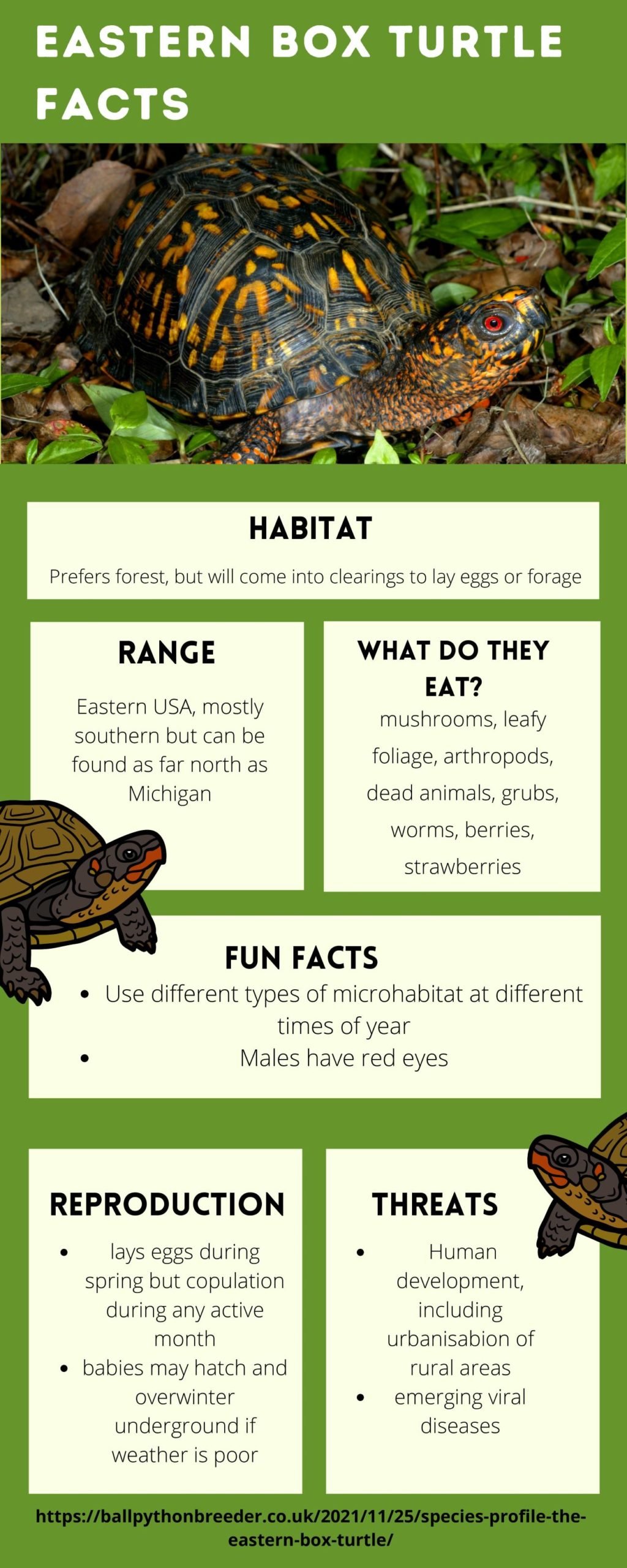In this week’s species profile, we take a look at the Eastern Box Turtle (Terrapene c. carolina). This subspecies is one of the most striking terrestrial Chelonians in all of North America.
Last updated on March 27th, 2023 at 11:27 am
I’ve cheated a tad here; the Eastern Box Turtle isn’t a full species: it is one of six living subspecies of the Common Box Turtle (Terrapene carolina). That said, it is unique enough to warrant its own dedicated article. Indeed, the Eastern Box Turtle is exceptionally colourful, intelligent, and widespread.
Description
Eastern Box Turtles are brightly coloured, with a carapace that ranges from brown to light yellow, set against a black background. More often than not, this lighter colouration forms irregular blotches and patterns in the centre of each scute.
On the plastron, dark colouration often occupies the outer edges of the scutes. On very old specimens, both the carapace and plastron may turn very dark brown.
The name Box Turtle comes from the morphology of their shell, which is essential to this species’ survival. Though the carapace is high-domed and rather tortoise-like, the plastron is unique, having a central hinge.
This hinge allows the turtle to retract its head and limbs, and essentially become a “box”. Given that they occupy many areas where raccoons, skunks and opossums are common, having a defence like this is a great way to avoid predation.
Juvenile Box Turtle’s have a much flatter shell, giving them a profile similar to that of their pond turtle relatives. Generally, they also have a central keel that runs the length of shell.
Eastern Box Turtle Habitat
This subspecies enjoys woodland habitat, and humid grassy areas adjacent to it. On occasion, it will enter shallow water when foraging, but does not swim. Certain individuals are particularly fond of the woodland edge, where finding wild strawberries, mushrooms and other fruiting plants can be easier.
In many parts of their range, this species regularly enters suburban areas that are close to its natural habitat. This leads to a great many being either killed on roads or collected for pets.
Eastern Box turtle Range
The Eastern Box Turtle enjoys the humid, temperate to subtropical habitat that is synonymous with the south-eastern United States.
Though their abundance can vary considerably, these turtles occupy terrestrial habitat all the way from extreme southern Maine to the Florida panhandle. To the west, the stretch of the Mississippi that forms the border of southern Illinois delimitates their territory.
In the north, Box Turtles can be found all the way to north-western lower peninsula Michigan.

Eastern Box Turtle Diet
Eastern Box Turtle’s are an omnivorous species that enjoys variety. Nonetheless, there is a shift in their dietary habits from hatchling to adult. Namely, juveniles eat much more live prey, and even carrion, than adults.
This may come as a surprise given how cute they look, but some juveniles and adults are voracious when they see exposed earthworms or mealworms.
In general, these turtles enjoy mushrooms, leafy foliage, arthropods, dead animals, grubs, worms, berries, strawberries. On occasion, they may attack juvenile rabbits or rodents that are too young to defend themselves.
Differences between females and males
As with many reptiles, the males of this species tend to be more brightly coloured. Intensity of colour is probably a proxy for health and may therefore signal a male’s reproductive fitness to a female.
On top of this brighter colouration, most male Eastern Box Turtles also have bright red eyes. This makes them look very striking. Though not a hard and fast rule, eye colour is generally a good way of sexing these animals without picking them up.
Another way to sex them is to look at the plastron. In males it is concave, whereas in females it is flat.
Female Eastern Box Turtles and males tend to be of a similar size, though some males are actually larger. This is typical of terrestrial chelonians, who engage more often in male-male combat than aquatic species.

Breeding
Eastern Box Turtles will mostly copulate in early spring or fall, then lay eggs in April or May. If the female found a suitable nesting site, and the weather has been good, the eggs will hatch after around two months.
If, however, the weather is poor and incubation takes longer, the baby turtles may hatch and spend the winter underground.
Given that female Box Turtles can store sperm, the timing of copulation and egg-laying is subject to variation. It is possible for a female to abstain from fertilising and laying eggs for several years, though this probably isn’t the norm.
Likewise, a female Eastern Box Turtle can also lay more than one clutch in a year. This likely depends on resource availability.
For their part, males try to mate with as many females as possible, whenever possible. They also engage in combat, often quite viciously, when they encounter each other.
Size
Eastern Box Turtles are a relatively small species. Carapace length is generally 5 to 6in (13 to 15cm). This means you can easily pick up an adult with one hand.
Hatchling Box Turtles are comparative in size to most other Emydidae species and are usually around 1 inch (2.5cm) long.

Eastern Box Turtle Facts
Eastern Box Turtles are incredibly smart. Not in a solving calculus kind of way, but more in the sense that they know what kind of habitat is best for them at a given time of year.
In one study, this species was found to prefer woodland habitat during most of the year, then switch to forest edge during May when food was abundant there. What’s more, the females observed moved from their preferred forest habitat to recently cleared land when it came time to lay.
This is important evidence that this species exploits what is known as complementarity between microhabitats. That is to say they make the most out their habitat by moving around it according to the season or their reproductive cycle.
If you’d like to learn more, check out the study: Thermal Regulation and Habitat use of the Eastern Box Turtle in Southwestern Virginia.
How rare is the Eastern Box Turtle?
Years ago, the Eastern Box Turtle was regularly encountered across much of its range. And though there was considerable variation in abundance within states, it was a broadly common species.
These days, however, T. c. carolina is listed as vulnerable. The main reasons for this being habitat destruction and urbanisation, though emerging reptile diseases, road mortality and collection for the pet trade also play a role.
Is it legal to own an Eastern Box Turtle?
In Europe it is generally legal to own an Eastern Box Turtle. This is because European stock is either captive bred or imported under permit.
In the US, however, it is only legal to own Eastern Box Turtles in certain states. At the time of writing, wild Box Turtles are legally protected by the majority of States that they call home. This means wild collection for non-scientific purposes is a state crime.
Notwithstanding, there still a few states where, upon obtaining a licence, it is legal to capture or own a small number of Box Turtles. What you need to be aware of, though, is it that these laws are changing over time.
If you wish to keep an Eastern Box Turtle – even captive bred – you must consult your state’s current laws first.

What do you do if you find an Eastern Box Turtle?
First and foremost, this website does not recommend that you keep an Eastern Box Turtle that you find. The wild population of this species is dwindling fast, and removal one from the wild does real harm. Also, wild caught animals almost always make terrible pets, often dying after just a few weeks or months.
If you do find an Eastern Box Turtle, you may have to move it, however. A major cause of mortality in this species is being hit by vehicles. In suburban environments they also succumb to injuries from falls on occasion.
When you find a Box Turtle, you need to ask yourself: Where was this guy going? If the animal was near a road, or on the road, pick it up carefully and put it away from the road on the side it was headed towards. Otherwise, it will simply try to cross again.
If, on the other hand, you find a Box Turtle trying to crawl through a fence, or along a wall, try to release it to the nearest patch of woodland that it could have been heading to. Generally, they do know where they’re going, it’s just a case of looking which direction they were aiming for.
Eastern Box Turtle Summary
| Habitat | woodland and humid grassy areas adjacent to it |
| Range | Eastern and south-eastern USA |
| Diet | mushrooms, leafy foliage, arthropods, dead animals, grubs, worms, berries, strawberries |
| Are they sexually dimorphic? | Yes |
| Breeding mode | Polygamous, egg laying |
| Size | 5 to 6in (13 to 15cm) |
| Activity Pattern | Diurnal |
| How rare are they? | Vulnerable and in decline |
Infographic: Eastern Box Turtle Facts


